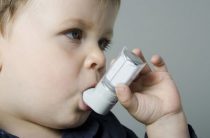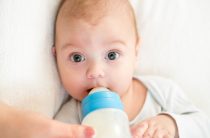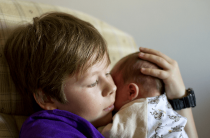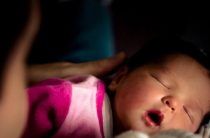Allergies are experienced by both children and adults. Today we will talk about small beautiful creatures - about kids. Often they have allergic reactions of a different nature. Allergies can occur to food, drugs, and pollen - this is not the whole list of allergens. With a variety of types of allergies, the temperature can rise. Moreover, she is able to achieve high performance.
In general, this symptom is quite rare, as it is not typical for such a problem.
Nevertheless, it can occur due to the reaction of the child's immunity to environmental factors. Often the temperature rises not because of allergies, as many assume. Its increase can cause other diseases that occur in parallel. These include diseases associated with the respiratory system, and acute respiratory viral infections. It's just that the parents haven't figured it out yet. And there is nothing to think about allergies, all the symptoms are reflected externally.
Is fever possible with allergies?
Let's look at the question of why children can have an increase in body temperature during allergies. This process occurs in the following situations:
- When a child has an allergy to some food.
- If you have allergies to medications.
- With intolerance to dust, animal hair, and pollen.
- An increase in body temperature can provoke a bite of any insect. But in this case, there are other symptoms. These include high blood pressure numbers and, which is a mortal danger for a child, pulmonary edema.
- The temperature could rise to 38 degrees due to the recent vaccine that the child was given as a preventive measure. Higher rates are noted in rare cases.
An elevated temperature can occur with poisoning, with colds. In what situations? If there are no complaints, except that the allergy is manifested:
- rashes on the skin,
- skin itching,
- the presence of diarrhea.
How does a drug allergy manifest itself?
In children and adults, the symptoms are very similar.
Let's get to know them better. Often this type of allergic reaction has a bright and very different manifestation of symptoms.
With such an allergy:
- The mucous membranes become inflamed and swollen.
- There is an increase in body temperature.
- The skin is flaky and itchy.
- Various rashes appear on the skin, intoxication is possible.
Allergy to food
This type of allergic reaction is extremely common at this time. In the case of this type of allergy:
- blood pressure can change dramatically;
- the child feels hot;
- pain in the abdomen, colic, diarrhea;
- on the skin there is a rash that acquires a brighter red tint;
- headache;
- increased sweating.
There is also an increase in temperature. It can reach both 39 and 40 degrees. So it is recommended to resort to calling an ambulance.
protein allergy
Protein intolerance is most often reflected on the skin in the form of rashes, swelling, itching. In children under one year old, dermatitis can form in the folds of the skin. In this case, the skin becomes flaky and dry. It is very easy to confuse these symptoms with diaper rash in babies. Also, in infants, it is difficult not to notice milk crusts (seborrheic dermatitis).
How does protein allergy manifest in older children? For the most part, allergies affect the mucous membranes of the child. For example, there is the occurrence of rhinitis, which has an asthmatic component. The mucous membranes of the eyes are also gradually affected. How is this process expressed? The baby has tears, the eye protein membranes swell. Also, one should not forget about the progression of the disease, like conjunctivitis.
Typical symptoms are redness, itching.
By the way, even a child may think that there is sand in the eyes. Enterocolitis is almost always noted. Why? Because this allergen enters the body through the gastrointestinal tract. In this case, there are conditions that cause discomfort in the gastrointestinal tract (they are called dyspeptic syndrome). This syndrome causes:
- pain;
- flatulence;
- nausea;
- diarrhea.
With regards to babies, babies, parents can observe:
- a state of anxiety (it is caused by accumulations of gases, colic);
- stool changes.
What is pollinosis?
Pollinosis is called an allergy to different pollen, for example, a tree, a flower. Like an allergy to animal hair, it can be accompanied by lacrimation, a slight rise in temperature (from 37 to 38 degrees). Redness, eyes, their itching, swelling are also characteristic. The mucous membranes of the nasopharynx, nose become inflamed. There is a cough, a violation in breathing - difficulty in inhaling and exhaling, coughing, sneezing.
Urticaria also begins on the skin of the child. Often, places such as the neck, arms, legs, that are, visible and not closed parts of the body, are affected. During the course of the allergic process, children are in a weakened state, they may have a headache, they are often naughty, they refuse to eat.
Allergy to pollen can lead to bronchial asthma, to asthmatic bronchitis. What will happen if a sick child stays in an environment with pollen for a long time? Different consequences are possible: not only are the mucous membranes inflamed, but harmful bacteria can also be connected, causing more serious diseases, for example:
- sinusitis (affects the nasal mucosa or its paranasal sinuses);
- conjunctivitis (inflammation of the mucous membrane of the eye).
Allergy to wool
With an allergy to wool, the baby sneezes, his skin swells and itches a lot, tearing and a runny nose are noted. Also, wool allergy can be recognized by the symptoms:
- most often these are small rashes;
- dyspnea;
- hives;
- allergic rhinitis;
- neurodermatitis;
- eczema;
- allergic rhinitis.
Allergy to the fur of adored pets - cats and dogs, is quite widespread. Let's look at the situation with dogs first.
In most cases, allergies can be picked up from short-haired dogs. This is due to the fact that a large amount of the allergen is present in the skin of dogs. It is referred to as Can F1. Be aware that the allergen can hide in furniture, toys and other items for a certain number of months.
So even careful cleaning will not get rid of them.
Ticks, which are very small and live in the coat of dogs, also contribute to the occurrence of allergic reactions. Allergy to dog hair is manifested as follows:
- red eyes;
- tears flow;
- itchy skin;
- as the nasopharynx swells, it becomes difficult to breathe;
- there is a dry cough.
On the skin, the symptoms of this type of allergy can be noticed after the saliva of the dog gets on it. Allergens are able to settle in various places where she got. People with bronchial asthma have an increased reaction and negative consequences to them.
The next item to consider will be cat hair. If you think that the hair of these representatives of the animal world is an allergen, you are mistaken.
What exactly causes an allergy? It is caused by a secretory protein in the skin of a cat, as well as her saliva. Such allergens are noted in every animal representative of the feline genus. Everyone knows that a cat cannot but take care of its hair, it always licks itself.
So, allergens are present in all her habitats (it doesn’t matter if she is lying down, sitting or just walking around). A fairly large amount of the allergen is formed in the places of her stay (on carpets, baby toys, etc.). Cats tend to produce less allergens than cats. By the way, did you know that many other allergens can be excreted in cat urine?
We conclude that in the entire habitat of these friends we adore, there are a lot of allergens that lead to allergic reactions. What are the symptoms of such an allergy? Initially itchy and stuffy nose. This symptom is very easy to confuse with the symptoms of completely different colds. The main symptoms appear as follows:
- itching all over the skin;
- it becomes difficult to breathe, there is a cough, the voice becomes a little hoarse;
- tears flow;
- there is an acute angioedema, urticaria.
Allergy to insect stings
How can insects harm human health, in particular children? Take bees and wasps as an example. Allergies in a child and a temperature are possible after they bite.
If the baby has an allergic reaction to honey and the general sensitivity is increased, after such a bite, a rather strong inflammatory process may begin. In the affected areas, symptoms such as pain and burning are noted. Also, these areas swell, the pressure rises. Acute angioedema is not excluded.
Examination by a phthisiatrician
Parents should always monitor the health of the child, for the slightest changes in his well-being. Due consideration should be given if:
- enlarged lymph nodes;
- for several months, children older than two years of age have a temperature of 37.1 to 37.5 degrees;
- any manifestations of allergies are noticeable.
Which doctors to contact? It is recommended to consult doctors:
- infectious diseases doctor;
- phthisiatrician.
Since the above symptoms may indicate the presence of infectious diseases or tuberculosis, you need to contact them. With pulmonary tuberculosis, there is increased sweating, a slight cough, lethargy and the above body temperature, while there are no other symptoms.
How to cure fever in a child?
So, let's discuss the measures that should be taken when the temperature rises due to allergies. In this case, you need to get rid of the allergen that causes the disease. Let's take an example. You are walking with your child on the street and notice how he begins to sneeze, cough, or other similar symptoms appear. They may indicate an allergy to various pollens. Then you should immediately leave this place.
Another situation: if you suspect signs of an allergy to wool, give your beloved animal to friends or relatives for a certain period.
After you get rid of the allergen, resort to the help of a drug.
Absolutely anyone with an antihistamine effect will do (for example, Claritin, Suprastin). If the body temperature does not exceed 38 degrees, doctors do not advise lowering it.
Is it possible to do without the use of drugs? Yes, sure. Very good for:
- milk with honey;
- tea with lemon or raspberry;
- ordinary water.
In general, temperature during allergic reactions is rarely noted. Despite this fact, the recommendation is: never treat your baby on your own without consulting a specialist! You can think for a long time, assume that contributed to the increase in temperature. Instead of thinking, go to a doctor who can help determine the specific cause and prescribe the appropriate treatment.
Which doctor should I contact? In this matter, either an allergist or your pediatrician will help.
If you need advice about allergies in your crumbs, please contact our specialist! Do not let the child's illness take its course, treat on time!















